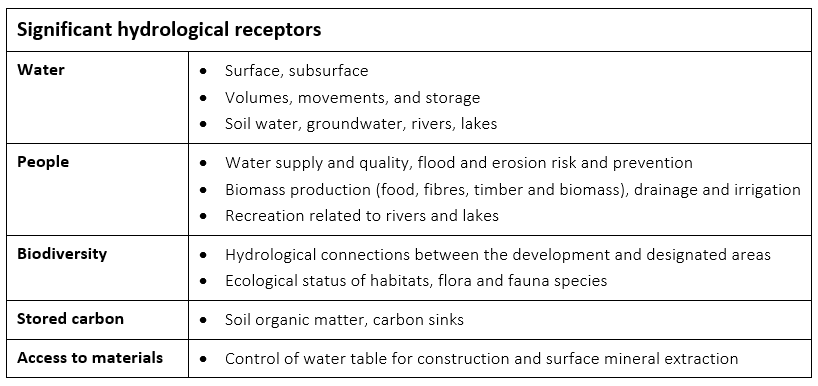
We don’t just benefit from healthy ecosystems. We rely on them. WHS is ensuring that all development impacts are considered.
Climate change is real and the environment matters. These simple self-evident truths underpin the ways our work is evolving, and we are determined to ensure that environmental impact assessment (EIA) considers all the implications and consequences of development fully.
At an immediate practical level, this ensures environmental statements of value, and effective construction and environmental management plans.
Ultimately at stake is the natural capital (natural assets which include geology, soil, air, water and all living things) in and around development sites, and the ecosystem services (benefits) we derive from them, and which make human life possible.
Connecting with other specialists in multi-disciplinary EIA teams, we focus on the impacts of development on the hydrological cycle.
The overall objective of EIA is for development to use the hydrological cycle sustainably.
The hydrological cycle
The hydrological cycle is the continuous circulation of water between the atmosphere, land and sea. The most relevant part of the cycle for us is the movement of water along terrestrial ‘pathways’ (on and in the ground) between the atmosphere and the sea.
Pathways are the routes between sources and receptors. Precipitation (for example rain) is one significant source and people, properties, and habitats are all examples of receptors.
When precipitation reaches the ground, pathways include flows:
- running over the soil surface (runoff)
- infiltrating the soil and moving laterally and vertically through it (soil water)
- percolating into the rocks under the soil (groundwater).
Runoff, soil water and groundwater all go ‘downslope’ and through the rocks to enter streams, rivers, open water bodies and the sea.
Together with the transpiration and evaporation of water back into the atmosphere from plants, land and water surfaces, this is the terrestrial part of the hydrological cycle, before water enters the sea and returns to the atmosphere by evaporation.
Development that disturbs these pathways can have significant effects on the cycle.
It can reduce infiltration and the soil’s water-storage capacity, and increase runoff. This in turn can increase erosion risk, downstream flood risk in river catchments, and change levels of water tables in receiving sites and lower-lying areas.
Ground disturbed by development can generate water-borne contamination via the soil-water pathway, with downstream and other water transmission effects. Increased surface runoff can also result in particulate contamination, for instance nitrogen and phosphate enrichment and the eutrophication of watercourses, and an increase in suspended solids such as silt.
The receptors of hydrology-dependent ecosystem services vulnerable to development include residents in urban areas and species in habitats sensitive to hydrological changes.
Sustainable drainage systems (SUDS) reduce the effects of urban development on hydrology, and the interruption of a soil-water pathway can play an important part in the reduction of contamination present on brownfield sites.


EIA methodology
Environmental perspectives evolve continuously. Because of this, we are developing an EIA methodology to evaluate impacts on hydrological-cycle pathways and receptors.
In line with established practice, the significance of the development impacts will be determined by:
- the scale and nature of the development, including both hard and soft development
- the environmental, social and economic sensitivity of baseline conditions at the development location
- the magnitude of the impacts.
The last word
WHS has undertaken the hydrology, hydrogeology and geology chapters for EIAs for significant projects including on-shore wind farms, solar farms, road schemes and housing developments.
We will use our EIA methodology to ensure a robust and consistent assessment of development impacts.
WHS has taken on Chris Stapleton, a soil scientist who has used soil information within environmental planning for over four decades. He will enhance our expertise at the interface between hydrology and the terrestrial part of the hydrological cycle.